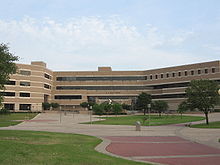- Mays Business School
-
Mays Business School 
Established 1961 Type Public School Dean Dr. Jerry Strawser Students 4,686[1] Undergraduates 4,002 Postgraduates 684 Location College Station, TX, USA Affiliations AACSB Website http://mays.tamu.edu/ Mays Business School is the business school at Texas A&M University. The school educates over 4,500 students in undergraduate and postgraduate programs and consistently ranks among the top public business schools in the nation.
Mays Business School was one of the first five schools in the United States to offer a trading center, the Reliant Energy Securities & Commodities Trading Center, which provides students with hands-on training to the tools used by commodities and currency traders.[2] Students also use the center to manage the Tanner Fund, a $250,000 portfolio created using donated funds.[3] Additionally, the School houses the nation's largest publicly funded real estate research organization, the Real Estate Center,[4] and the Center for Retailing Studies, which was the first retailing center partnered with a business school.[5]
Contents
History
Business education was first offered at Texas Agricultural and Mechanical College in conjunction with mechanical and agricultural programs. From 1876 through 1920 students at Texas A&M could select from a small number of business courses including single and double-entry bookkeeping and creamery management. In the 1920s the Department of Economics and the Agricultural Administration programs began offering further business courses, and by the end of the decade the college had established departments for accounting and statistics, farm and ranch management, marketing, and finance.[6]
Shortly after the conclusion of World War II, Thomas W. Leland became the first department head of the newly created Department of Business and Accounting, under the umbrella of the School of Arts and Sciences. After Leland's retirement in 1961, the School of Business Administration formed. By 1965 the new head of the department, John E. Pearson, had spearheaded the formation of several departments within the School of Business, including accounting, business analysis and research, finance, marketing, and management. The Master of Business Administration (MBA) program debuted in 1966, and two years later, when Texas A&M received University status, the School of Business became the College of Business Administration.[6]
The college was accredited by the American Assembly of Collegiate Schools of Business in 1972, and began awarding Ph.D.s the same year. Over the next several decades the college continued to grow, establishing various centers, including the Center for International Business Studies and the Center for Human Resources Management, and implementing new bachelor's degrees.[6]
The College of Business moved into the newly-built Wehner Building on the western edge of Texas A&M University's campus in 1995. The following year the College was endowed by Lowry Mays, founder of Clear Channel Communications, and was renamed in his honor.[6] Expansion continued quickly, and in 2003 an additional wing was added to the Wehner Building, housing the new 66,000-square-foot (6,100 m2) Jerry and Kay Cox Graduate Business Center.[7]
Academics
School rankings (overall) U.S. undergraduate business Bloomberg BusinessWeek[8] 48 U.S. MBA Bloomberg BusinessWeek[9] 30 Forbes[10] 24 U.S. News & World Report[11] 32 Worldwide MBA Financial Times[12] 44 The business school is subdivided into five academic departments: accounting, finance, information & operations management, management, and marketing.
Undergraduate degrees
- Bachelor of Business Administration (BBA)
- Accounting
- Business Honors
- Finance
- Information & Operations Management
- Management Information Systems
- Supply Chain Management
- Management
- Marketing
- Bachelor of Science (BS)
- Certificate Programs
- Certificate in Entrepreneurial Leadership
- Certificate in European Union Business
- Certificate in Latin American Business
- Certificate in International Business
- Certificate in Retailing
- Minor
Graduate degrees
- Master of Business Administration (MBA)
- Two-Year Program
- Executive Program
- Master of Science (MS)
- Accounting
- Finance
- Human Resources Management
- Management Information Systems
- Marketing
- Master of Real Estate
- Master of Agribusiness
- Certificate Programs
- Certificate in Entrepreneurship
- Certificate in Business (for non-business graduate students)
- Doctor of Philosophy (Ph.D.)
- Accounting
- Finance
- Management
- Marketing
- Operations and Supply Chain Management
Research centers
- Center for Executive Development (CED)
- Center for Human Resource Management (CHRM)
- Center for International Business Studies (CIBS)
- Center for the Management of Information Systems (CMIS)
- Center for New Ventures and Entrepreneurship (CNVE)
- Center for Retailing Studies (CRS)
- Real Estate Center (REC)
- Reliant Energy Trading Center (RTC)
See also
- List of United States business school rankings
- List of business schools in the United States
References
- ^ "Finger Tip Facts - Spring 2011". Texas A&M University. http://www.tamu.edu/customers/oisp/student-reports/fingertip-facts-spring-2011.pdf. Retrieved 2011-02-17.
- ^ Zuehlke, Lara (February 2001). "Bridging the Gap: Trading center puts students in touch with the business world". Mays Business Online. http://maysbusiness.tamu.edu/2001/02/tradingctr.html. Retrieved 2007-04-02.
- ^ "The Reliant Energy Trading Center". Texas A&M University. http://mays.tamu.edu/centers/rtc/about.htm. Retrieved 2007-04-02.
- ^ "About RECenter". Texas A&M University. http://recenter.tamu.edu/info/about.html. Retrieved 2007-04-02.
- ^ "Center for Retailing Studies". Texas A&M University. http://mays.tamu.edu/centers/crs/index.php. Retrieved 2007-04-02.
- ^ a b c d "College History: Mays Business School Timeline". Texas A&M University. Archived from the original on 2007-02-04. http://web.archive.org/web/20070204124958/http://mays.tamu.edu/aboutus/history/. Retrieved 2007-04-02.
- ^ "A Catalyst for Learning". Mays Business Online. October/November 2003. http://maysbusiness.tamu.edu/2003/10/catalyst.html. Retrieved 2007-04-02.
- ^ "Business School Rankings and Profiles: Undergraduate". Bloomberg BusinessWeek. 2010. http://www.businessweek.com/bschools/rankings/. Retrieved 2011-1-19.
- ^ "Business School Rankings and Profiles: MBA". Bloomberg BusinessWeek. 2010. http://www.businessweek.com/bschools/rankings/. Retrieved 2011-1-19.
- ^ "Best Business Schools". Forbes. 2011. http://www.forbes.com/lists/2011/95/best-business-schools-11_land.html. Retrieved 2011-10-16.
- ^ "Best Business Schools". U.S. News & World Report. 2011. http://grad-schools.usnews.rankingsandreviews.com/best-graduate-schools/top-business-schools/mba-rankings. Retrieved 2011-1-19.
- ^ "Global MBA Rankings". Financial Times. 2011. http://rankings.ft.com/businessschoolrankings/global-mba-rankings-2011. Retrieved 2011-1-19.
Categories:- Texas A&M University colleges and schools
- Business schools in Texas
- Educational institutions established in 1961
- The Washington Campus
- Bachelor of Business Administration (BBA)
Wikimedia Foundation. 2010.

